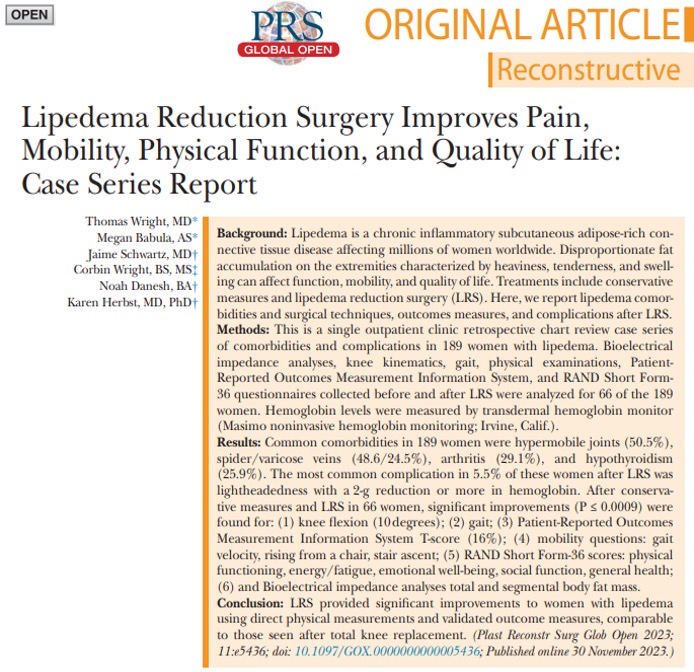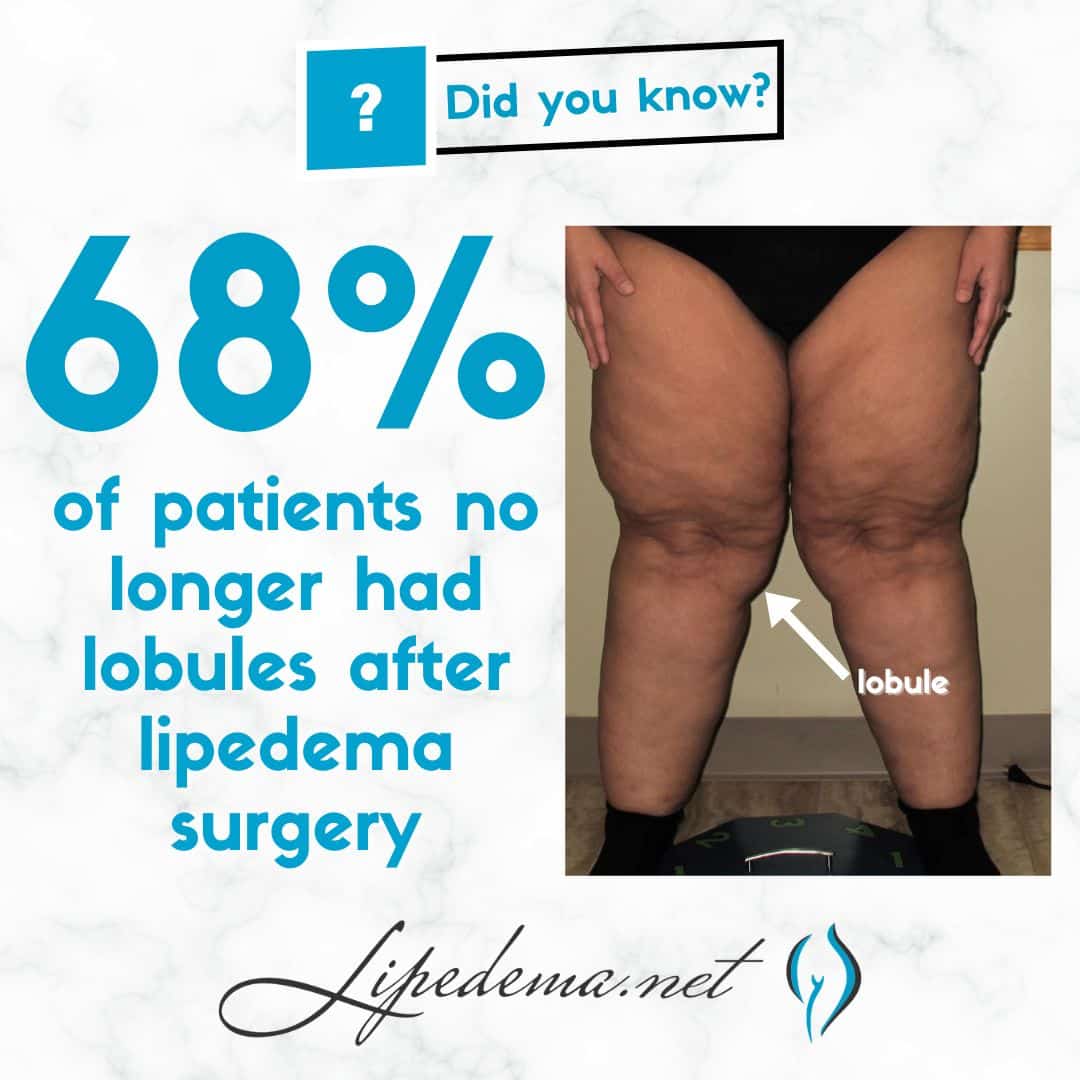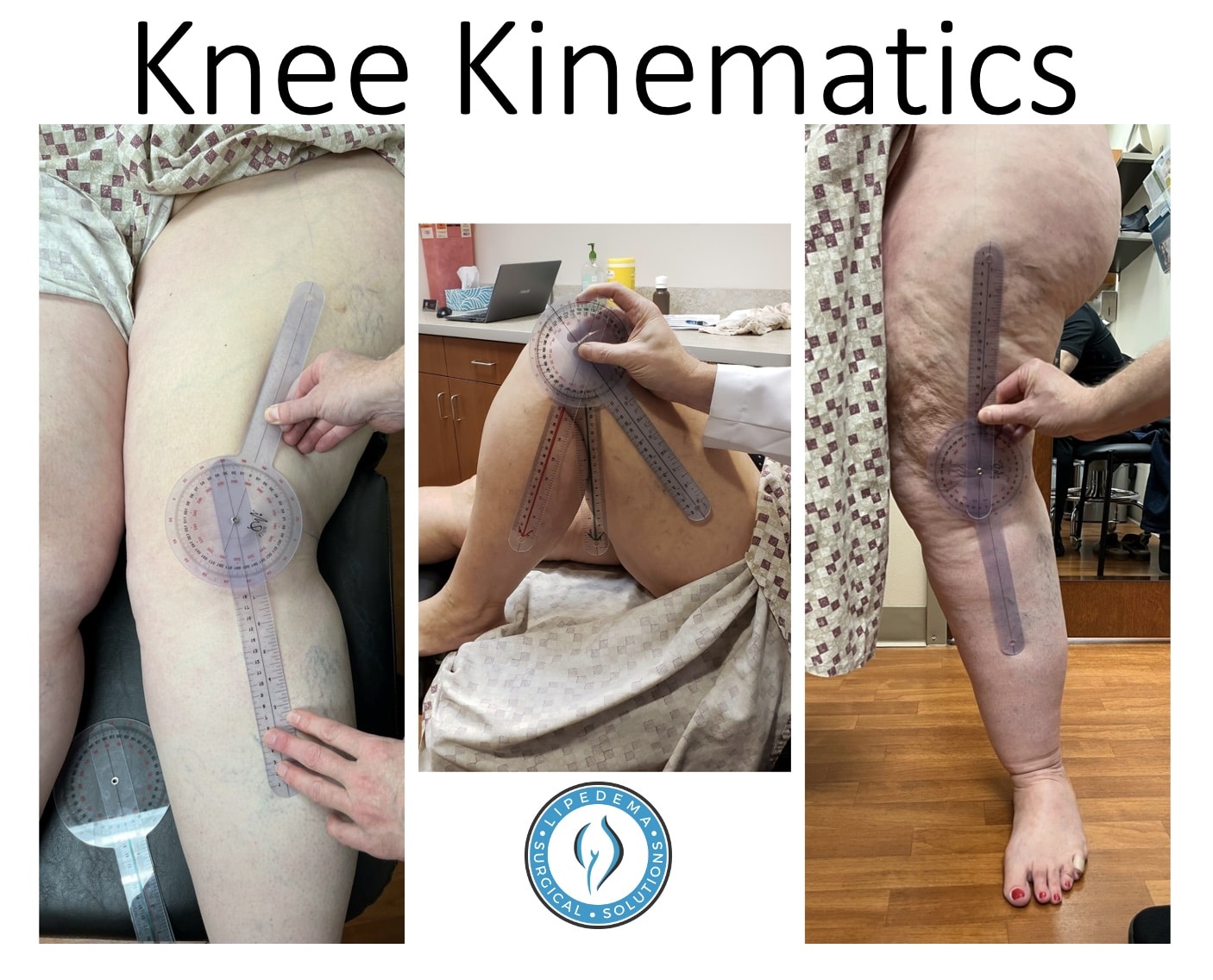In November 2023, Dr. Wright published the first paper that looked at outcomes from Lipedema Reduction Surgery in the United States. The groundbreaking research documents knee joint improvement and gait improvement from Lipedema Reduction Surgery, showing that Lipedema Reduction Surgery outcomes are equal to or better than Total Knee Replacement in improving knee mechanics, gait, physical function, and pain.
The groundbreaking research was also the first to:
- Correlate patient-reported outcomes with objective physical measurement improvements.
- Show improvement in mobility measurements that correlate with future disability and life expectancy.
- Use the same outcome measurements used in Orthopedic literature, which shows improvements in mobility, quality of life measurements, and knee flexion comparable to or better than a Total Knee Replacement.
The paper, “Lipedema Reduction Surgery Improves Pain, Mobility, Physical Function, and Quality of Life,” is the first of its kind and provides valuable insight into the benefits of undergoing Lipedema Reduction Surgery, including mobility improvements that have been correlated with a reduction in the development of disability and improved mortality. The new peer-reviewed publication presents a case series comparing data collected before and after undergoing Lipedema Reduction Surgery, a modified lymph-sparing liposuction performed by Dr. Thomas Wright.

Lipedema is a subcutaneous adipose-rich connective tissue (SAT) disease that affects a significant percentage of women worldwide. Characterized by limb heaviness, pain, and disproportionate accumulation of lipedema tissue, this condition can significantly impact a person’s daily activities and overall well-being. However, recent advancements in medical science have led to the development of a groundbreaking treatment known as Lipedema Reduction Surgery (LRS), which has shown remarkable results in improving mobility, reducing pain, and enhancing the quality of life for women with lipedema.
Understanding Lipedema: A Misunderstood Condition
Lipedema is often misdiagnosed as obesity, leading to a lack of awareness and recognition within the medical community and the general population. It is estimated that 6% to 19% of women are affected by this condition, yet many do not receive the treatment they need. Lipedema is characterized by the disproportionate accumulation of lipedema tissue in the legs, hips, and arms, leading to limb heaviness, pain, and mobility impairment. The disease progresses through three stages, with stage 3 lipedema presenting lobules of skin and SAT.

The Need for Effective Treatment: Lipedema Reduction Surgery
Currently, lipedema has no cure, and treatment focuses on symptom management and preventing complications. Lipedema Reduction Surgery (LRS) has emerged as a highly effective treatment option for women with lipedema. Unlike cosmetic liposuction, LRS is a validated surgical technique that prioritizes functional improvement, pain reduction, and swelling reduction rather than aesthetic changes. This innovative procedure aims to remove large amounts of fibrotic tissue in a single treatment, slowing the progression of lipedema and preventing complications and disability.

The Benefits of Lipedema Reduction Surgery
Improved Mobility and Knee Function
One of the most significant benefits of Lipedema Reduction Surgery is the improvement in mobility and knee function. A study published in the journal Plastic and Reconstructive Surgery Global Open demonstrated that LRS resulted in a 10-degree improvement in knee flexion after surgery. This improvement in knee mechanics and range of motion is comparable to or better than the improvements seen with total knee replacement, a procedure commonly used to treat arthritis. Additionally, overall mobility, walking speed, and stair ascent also improved significantly with LRS, leading to a greater ability to perform daily activities and a decreased risk of disability.

Decreased Pain and Enhanced Quality of Life
Lipedema can cause significant pain and discomfort, impacting a person’s quality of life. However, LRS has been shown to alleviate pain and improve overall well-being in women with lipedema. Patient-reported outcomes demonstrated decreased pain levels and improved emotional and social well-being after surgery. Furthermore, LRS resulted in tissue changes consistent with regression of stage in some patients, indicating a positive impact on the progression of the disease. Overall, LRS has been correlated with an enhanced quality of life and increased life expectancy for women with lipedema.

Comparable Effectiveness to Total Knee Arthroscopy
A retrospective chart analysis comparing the effectiveness of LRS and total knee arthroscopy for treating lipedema and arthritis showed that LRS is at least as effective as total knee arthroscopy. Using the same outcome measures, LRS demonstrated improvements in knee mechanics, range of motion, and gait comparable to those seen with total knee arthroscopy. This finding highlights the efficacy of LRS as a treatment option for lipedema, providing comparable results to a procedure widely used for arthritis management.
The Procedure: How Lipedema Reduction Surgery Works
Lipedema Reduction Surgery is a surgical procedure that focuses on removing fibrotic tissue and improving functional outcomes in women with lipedema. The surgery, a derivative of lymph-sparing liposuction, is fundamentally different from cosmetic liposuction as it aims to address the functional impairments caused by lipedema rather than purely aesthetic concerns. The procedure involves using cannulas attached to suction to remove diseased fat and fibrotic tissue, focusing on protecting lymphatic structures and minimizing the risk of lymphatic injury.
To ensure the safety and effectiveness of LRS, preoperative mapping of venous and lymphatic structures is performed using techniques such as vascular Doppler ultrasound or indocyanine green direct lymphography. This mapping helps identify the principal superficial veins and lymphatic structures, allowing the surgeon to navigate around these vital structures during the surgery, reducing the risk of transection. Additionally, meticulous attention is paid to tumescent anesthesia, lidocaine dosage, and risk stratification for deep vein thrombosis (DVT) to optimize patient safety and minimize postoperative complications.

Research Findings and Patient Outcomes
Numerous studies have highlighted the positive outcomes and benefits of Lipedema Reduction Surgery. In a retrospective chart analysis of 189 women who underwent 507 procedures, improvements were observed in various aspects of patient outcomes. Knee kinematics and mechanics significantly improved, with increased knee flexion and reduced valgus deviation. Bioelectrical impedance analysis demonstrated a decrease in total body and segmental body fat mass and a decrease in percentage body fat.
Patient Reported Outcomes
- 16% increase in patients’ ability to walk at a normal speed.
- 16% increase in patients’ ability to go up and down stairs.
- 27% increase in patients’ ability to run a short distance.
- 12% increase in patients’ ability to stand for one hour.
Patient-reported outcomes, measured using surveys such as the PROMIS (Patient-Reported Outcomes Measurement Information System) and SF-36 (RAND Short Form-36 Medical Outcomes Study), showed significant improvements in physical function, pain levels, and overall quality of life. Patients reported improvements in walking speed, ability to ascend and descend stairs, and the ability to perform activities such as standing up from a chair. These mobility and quality of life improvements were comparable to or better than the outcomes seen with total knee arthroscopy for arthritis management.
The conservative treatments used in this case series are the same as those used in a previous pilot study by Dr. Wright to assess non-surgical lipedema treatment; in that study, mobility outcomes were followed before and after conservative treatment but did not show significant changes. Patients in the first study did not undergo surgery. Instead, they received diet instruction, wore compression, and used pneumatic pumps following the non-surgical, conservative treatment. While patients showed decreased pain and slightly decreased size of the limb (legs), they did NOT show the improvement in mobility, quality of life, or the improvement in knee function that we saw with the surgery.

Conclusion: A Promising Future for Lipedema Treatment
Lipedema Reduction Surgery has emerged as a revolutionary treatment option for women with lipedema, offering improved mobility, reduced pain, and enhanced quality of life. With its focus on functional improvement and pain reduction, LRS provides a viable alternative to nonsurgical conservative measures and offers lasting patient benefits. By raising awareness about lipedema and its treatment options, we aim to ensure that more women suffering from this condition receive the care they need to lead healthier, more fulfilling lives.
For more information on Lipedema Reduction Surgery and related research, visit Lipedema Surgical Solutions and Lipedema Foundation.
Meet Dr. Thomas Wright, a leading expert in Lipedema Reduction Surgery, at lipedemadoctor.com.

